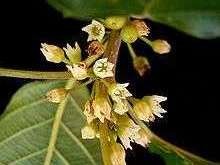Alderleaf buckthorn
(Endotropis alnifolia)

Description
Rhamnus alnifolia is a species of flowering plant in the buckthorn family known by the common names alderleaf buckthorn, or alder buckthorn. Unlike other "buckthorns", this alder buckthorn does not have thorns. It is native to North America, where it is known mainly from the southern half of Canada and the northern half of the United States and California. It can be found in forested habitat. Rhamnus alnifolia is a spreading shrub usually 0.5 to 1.5 metres (20 to 59 inches) tall, rarely to 2 m (6+1⁄2 ft), its thin branches bearing deciduous leaves. The thin, deeply veined leaves have oval blades 4.5 to 11 centimetres (1+3⁄4 to 4+3⁄8 in) long, pointed at the tip and lightly toothed along the edges. The inflorescence is a solitary flower or umbel of up to three flowers occurring in leaf axils. The tiny flowers are about 1 millimetre (1⁄16 in) wide and have five green sepals but no petals. Female flowers produce drupes 6 to 8 mm (1⁄4 to 5⁄16 in) wide, each containing three seeds. The drupes darken to black when ripe. Rhamnus is a genus of about 110 accepted species of shrubs or small trees, commonly known as buckthorns, in the family Rhamnaceae. Its species range from 1 to 10 m (3 to 33 ft) tall (rarely to 15 m, 50 ft) and are native mainly in east Asia and North America, but found throughout the temperate and subtropical Northern Hemisphere, and also more locally in the subtropical Southern Hemisphere in parts of Africa and South America. One species, the common buckthorn (Rhamnus cathartica), is able to flourish as an invasive plant in parts of Canada and the U.S., where it has become naturalized. Both deciduous and evergreen species occur. The leaves are simple, 3 to 15 cm (1 to 6 in) long, and arranged alternately, in opposite pairs, or almost paired (subopposite). One distinctive character of many buckthorns is the way the veination curves upward towards the tip of the leaf. The plant bears fruits which are black or red berry-like drupes. The name is due to the woody spine on the end of each twig in many species. One species is known to have potential to be used medicinally. Rhamnus species are shrubs or small to medium-sized trees, with deciduous or rarely evergreen foliage. Branches are unarmed or end in a woody spine. The leaf blades are undivided and pinnately veined. Leaf margins are serrate or rarely entire. Rhamnus species are generally dioecious, with male and female flowers on separate plants.
Taxonomic tree:







